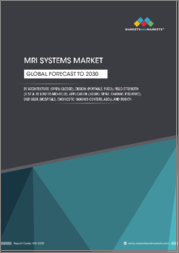
|
시장보고서
상품코드
1725767
세계의 MRI 시스템 시장 : 용도별, 아키텍처별, 디자인별, 자장 강도별, 최종사용자별, 지역별 - 예측(-2030년)MRI Systems Market by Architecture (Open, Closed), Field Strength (High Field MRI Systems & Low Field MRI Systems), Design (Portable MRI Systems, Fixed/Stationary MRI Systems), End User (Hospitals, Diagnostic Clinic), Region - Global Forecast to 2030 |
||||||
전 세계 MRI 시스템 시장 규모는 2025년 65억 달러에서 2030년 90억 달러에 달할 것으로 예상되며, 2025년부터 2030년까지 연평균 6.5%의 CAGR을 기록할 것으로 예상됩니다.
| 조사 범위 | |
|---|---|
| 조사 대상 연도 | 2024-2030년 |
| 기준 연도 | 2024년 |
| 예측 기간 | 2024-2030년 |
| 검토 단위 | 금액(10억 달러) |
| 부문 | 용도별, 아키텍처별, 디자인별, 자장 강도별, 최종사용자별, 지역별 |
| 대상 지역 | 북미, 유럽, 아시아태평양, 라틴아메리카, 중동 및 아프리카 |
시장의 성장은 특히 신경 및 근골격계 질환의 질병 부담 증가에 기인하며, 향후 몇 년 동안 증가할 것으로 예상됩니다. 고령화 인구의 증가, 암과 같은 만성질환의 유병률 증가로 인해 전 세계적으로 MRI 시스템에 대한 수요가 증가할 것으로 예상됩니다. 이러한 모든 요인들이 보다 광범위한 수준에서 MRI 시스템 시장의 성장에 기여할 것입니다.
MRI 시스템 시장은 자기장 강도별로 분류되며, 중저자장 MRI 시스템, 고/초고자기장 MRI 시스템, 초고자기장 MRI 시스템 등으로 분류됩니다. 고자기장 및 초고자기장 MRI 시스템은 우수한 신호 대 잡음비(SNR)로 주목받으며 임상적 유용성을 크게 향상시켰습니다. 이러한 시스템은 뇌, 근골격계 구조, 혈관계 영상뿐만 아니라 정신의학, 신경학, 생물학 연구, 다발성 경화증과 같은 질환의 조기 발견과 같은 특수한 응용 분야에서도 탁월한 성능을 발휘합니다. 헬륨 사용량이 감소하는 동시에 스캔 시간이 단축되고 이미지 해상도가 향상됩니다. 고자기장 MRI 시스템, 특히 1.5T 및 3T에서 작동하는 시스템은 현저하게 우수한 이미지 품질, 짧은 촬영 시간 및 광범위한 임상 적용 범위로 인해 저자기장 시스템(1T 이하)보다 선호되고 있습니다. 고자기장 시스템의 높은 SNR은 신경 질환, 근골격계 손상, 심혈관계 이상과 같은 복잡한 병태의 진단에 필수적인 보다 선명하고 상세한 영상 진단을 가능하게 합니다. 고속 스캔 기능은 환자의 처리량을 향상시킬 뿐만 아니라 의료 시설의 업무 효율성을 높입니다. 이러한 요인들이 복합적으로 작용하여 고자기장 MRI 시스템의 시장 도입이 확대되고 있습니다.
폐쇄형 MRI 스캐너는 소형 원통형 챔버를 이용하여 체내 구조의 고화질 영상을 생성합니다. 대부분의 고자기장 초전도 MRI 스캐너는 폐쇄형으로 설계되어 있습니다. 폐쇄형 MRI는 높은 자기장 강도로 인해 효율이 높고, 화질이 우수하며, 처리량이 증가하기 때문에 업계 표준으로 여겨지고 있습니다. 개방형 MRI는 동등한 평가를 얻기 위해 4-5회 스캔이 필요할 수 있지만, 폐쇄형 MRI는 보통 1-2회 스캔으로 검사가 완료됩니다. 이러한 효율성은 검사 시간을 단축시킬 뿐만 아니라 시술 및 치료의 임상적 유용성을 높입니다. 폐쇄형 MRI는 스캔 시간이 짧기 때문에 모션 아티팩트를 줄이고 환자 처리량을 향상시킬 수 있습니다. 또한, 기능적 MRI(fMRI), 확산강조영상(DWI), 심장 MRI 등 높은 자기장 강도가 정확도를 좌우하는 첨단 영상 진단 기술에도 대응하고 있습니다.
MRI 시스템 시장은 크게 고정형 MRI 시스템과 휴대용 MRI 시스템으로 나뉩니다. 고정형 MRI 시스템은 몇 가지 이유로 인해 일반적으로 휴대용보다 선호되고 있습니다. 우수한 화질, 전신 스캔 능력, 워크플로우 효율성 향상, 장기적인 비용 효율성 등을 들 수 있습니다. 일반적으로 고정식 MRI 장비는 자기장에 의해 작동됩니다. 고정식 MRI 장비의 또 다른 큰 장점은 전신 촬영이 가능하다는 점이며, 이는 시장 성장을 더욱 촉진하고 있습니다.
용도별로는 뇌 및 신경 MRI, 척추 및 근골격계 MRI, 골반 및 복부 MRI, 혈관 MRI, 유방 MRI, 심장 MRI, 소아 MRI, 기타 용도로 분류되며, 용도별로는 뇌 및 신경 MRI 분야가 예측 기간 동안 가장 높은 성장률을 기록할 것으로 예상됩니다. 이 부문의 빠른 성장에 기여하는 주요 촉진요인으로는 첨단 AI 기술의 통합과 내부 장기를 정확하게 타겟팅할 수 있는 혁신적인 장비의 채택이 확대되어 실시간 이미징 기능이 향상되고 있는 점 등이 있습니다.
세계 MRI 시스템 시장은 최종사용자별로 병원, 영상 진단 센터, 기타 카테고리로 분류되며, 2024년에는 병원 부문이 가장 큰 시장 점유율을 차지할 것으로 예상됩니다. 이러한 우위는 주로 정확한 진단을 강화하고 조기 발견의 중요성에 대한 인식을 높이는 첨단 MRI 시스템의 병원 사용 증가에 기인합니다. 그 요인으로는 최근 제품 출시, 환자 치료 지원 기능이 향상된 첨단 시스템 도입 확대, 병원에서 시행되는 영상 진단 건수 증가 등을 꼽을 수 있습니다. 다양한 질환을 신속하고 정확하게 진단하고자 하는 수요가 증가함에 따라 많은 병원들이 첨단 MRI 시스템 도입을 우선순위에 두고 있습니다. 전용 영상처리장비를 갖춘 대형 국공립병원은 이러한 기술을 가장 먼저 도입했지만, 민간 병원에서는 시간이 지남에 따라 고급 영상처리 솔루션 도입이 진행되고 있습니다. 영상 처리 워크플로우의 현대화 추세는 병원에서의 MRI 시스템 도입을 더욱 촉진하고 있습니다.
MRI 시스템 시장은 5개 주요 지역(북미, 유럽, 아시아태평양, 라틴아메리카, 중동 및 아프리카)으로 나뉩니다. 특히 아시아태평양에는 경쟁력 있는 가격을 유지하면서 첨단 기술 기능을 갖춘 종합적인 MRI 양식을 제공하는 MRI 시스템 제조업체가 다수 존재합니다. 최종사용자, 특히 의료 기관은 최근 관세 제재로 인해 예산 제약에 직면하는 경우가 증가하고 있으며, 이는 중국 제조업체가 제공하는 비용 효율적인 MRI 솔루션으로 전환하도록 유도하고 있습니다. 이 지역의 제조 환경은 낮은 인건비와 풍부한 자원의 혜택을 받아 MRI 시스템의 효율적인 생산 공정을 촉진하고 있습니다. 이러한 역학으로 인해 아시아태평양 시장은 현지 수요 증가와 전략적 가격 책정으로 인해 전 세계 시장 중 가장 높은 성장률을 보일 것으로 예상됩니다.
세계의 MRI 시스템 시장에 대해 조사했으며, 용도별, 아키텍처별, 디자인별, 자장 강도별, 최종사용자별, 지역별 동향, 시장 진입 기업 프로파일 등의 정보를 정리하여 전해드립니다.
목차
제1장 소개
제2장 조사 방법
제3장 주요 요약
제4장 주요 인사이트
제5장 시장 개요
- 소개
- 시장 역학
- Porter's Five Forces 분석
- 규제 상황
- 상환 시나리오 분석
- 생태계 분석
- 밸류체인 분석
- 공급망 분석
- 가격 분석
- 특허 분석
- 무역 분석
- 기술 분석
- 고객 비즈니스에 영향을 미치는 동향/혼란
- 투자와 자금 조달 시나리오
- 2025-2026년의 주요 회의와 이벤트
- 주요 이해관계자와 구입 기준
- 사례 연구 분석
- MRI 스캔 응용, 2022-2024년
- MRI 시스템 시장에서 AI의 영향
- 미국 관세 : 2025년
제6장 MRI 시스템 시장(용도별)
- 소개
- 뇌와 신경 MRI
- 척추 및 근골격 MRI
- 혈관 MRI
- 골반 및 복부 MRI
- 유방 MRI
- 심장 MRI
- 소아 MRI
- 기타
제7장 MRI 시스템 시장(아키텍처별)
- 소개
- 폐쇄형 MRI 시스템
- 오픈 MRI 시스템
제8장 MRI 시스템 시장(디자인별)
- 소개
- 고정형/정지형 MRI 시스템
- 가동식 MRI 시스템
제9장 MRI 시스템 시장(자장 강도별)
- 소개
- 고자장-초고자장 MRI 시스템
- 저-중자장 MRI 시스템
- 초고자장 MRI 시스템
제10장 MRI 시스템 시장(최종사용자별)
- 소개
- 병원
- 진단 영상 센터
- 기타
제11장 MRI 시스템 시장(지역별)
- 소개
- 북미
- 북미 : 거시경제 전망
- 미국
- 캐나다
- 유럽
- 유럽 : 거시경제 전망
- 독일
- 영국
- 프랑스
- 이탈리아
- 스페인
- 기타
- 아시아태평양
- 아시아태평양 : 거시경제 전망
- 일본
- 중국
- 인도
- 호주
- 한국
- 기타
- 라틴아메리카
- 라틴아메리카 : 거시경제 전망
- 브라질
- 멕시코
- 기타
- 중동 및 아프리카
- 중동 및 아프리카 : 거시경제 전망
- GCC 국가
- 기타
제12장 경쟁 구도
- 소개
- 주요 진출 기업 전략/강점
- 매출 점유율 분석, 2020-2024년
- 시장 점유율 분석
- 2024년의 주요 진출 기업 순위
- 기업 평가와 재무 지표
- 브랜드/제품 비교
- 기업 평가 매트릭스 : 주요 진출 기업, 2024년
- 기업 평가 매트릭스 : 스타트업/중소기업, 2024년
- 경쟁 시나리오
제13장 기업 개요
- 주요 진출 기업
- SIEMENS HEALTHINEERS
- KONINKLIJKE PHILIPS N.V.
- GE HEALTHCARE
- CANON MEDICAL SYSTEMS
- FUJIFILM CORPORATION
- FONAR CORPORATION
- ESAOTE S.P.A
- SHANGHAI UNITED IMAGING HEALTHCARE CO., LTD.
- ASPECT IMAGING LTD.
- TIME MEDICAL HOLDING
- NEUSOFT MEDICAL SYSTEMS CO., LTD.
- STERNMED GMBH
- HYPERFINE, INC.
- SHENZHEN BASDA MEDICAL APPARATUS CO., LTD.
- SHENZHEN ANKE HIGH-TECH., LTD.
- 기타 기업
- MAGNETICA LTD
- AURORA HEALTHCARE US CORP
- INNERVISION MRI LTD.
- BEIJING WANDONG MEDICAL TECHNOLOGY CO., LTD.
- MEDONICA CO., LTD
- NEOSCAN SOLUTIONS GMBH
- KANGDA INTERCONTINENTAL MEDICAL EQUIPMENT CO., LTD.
- MINFOUND MEDICAL SYSTEMS CO., LTD.
- SYNAPTIVE MEDICAL
- XINGAOYI MEDICAL EQUIPMENT CO., LTD
제14장 부록
ksm 25.06.02The global MRI systems market is projected to reach USD 9.0 billion by 2030 from USD 6.5 billion in 2025, at a CAGR of 6.5% from 2025 to 2030.
| Scope of the Report | |
|---|---|
| Years Considered for the Study | 2024-2030 |
| Base Year | 2024 |
| Forecast Period | 2024-2030 |
| Units Considered | Value (USD billion) |
| Segments | Field Strength, Architecture, Design, Application, End User, and Region |
| Regions covered | North America, Europe, the Asia Pacific, Latin America, and the Middle East & Africa |
The market's growth can be attributed to an increase in disease burden, specifically for neurological and musculoskeletal conditions, which is projected to increase in the coming years. An increase in the aging population, with the rising prevalence of chronic diseases such as cancer, is anticipated to increase the need for MRI systems across the globe. All these factors, on a broader level, will help to grow the market for MRI systems.
By field strength, the high & very high field segment dominated the MRI systems market in 2024.
The MRI systems market is categorized by field strength, encompassing low-to-mid-field MRI systems, high and very high field MRI systems, and ultra-high-field MRI systems. High and very high field MRI systems are notable for their superior signal-to-noise ratio (SNR), which enhances clinical utility significantly. These systems are not only instrumental in imaging the brain, musculoskeletal structures, and vascular systems but also excel in specialized applications within psychiatry, neurology, biomedical research, and the early identification of conditions such as multiple sclerosis. The integration of MRI with complementary modalities such as PET and ultrasound further optimizes operational throughput and decreases helium usage while also delivering faster scan times and enhanced image resolution. High-field MRI systems, specifically those operating at 1.5T and 3T, are favored over low-field systems (below 1T) due to their markedly superior image quality, reduced acquisition times, and extensive range of clinical applications. The elevated SNR in high-field systems translates to clearer, more detailed imaging essential for diagnosing complex conditions such as neurological disorders, musculoskeletal injuries, and cardiovascular abnormalities. The rapid scan capabilities not only improve patient throughput but also enhance operational efficiency within healthcare facilities. Collectively, these factors have driven the growing adoption of high-field MRI systems within the market.
By architecture, the closed MRI systems segment accounted for the largest share of the market in 2024.
A closed MRI scanner utilizes a small cylindrical chamber to produce highly detailed images of the body's structure. Most high-field superconducting magnetic resonance imaging scanners are designed in a closed format. Due to their higher efficiency, superior image quality, and increased throughput-all resulting from greater magnetic field strengths-closed MRI systems are considered the industry standard. In contrast to open MRI systems, which may require up to four or five scans for a comparable evaluation, closed MRI systems typically complete the scanning process in just one or two scans. This efficiency not only shortens examination times but also enhances the clinical utility of procedures and therapies. Closed MRI offers faster scan times, which helps reduce motion artifacts and improves patient throughput, making it particularly suitable for high-volume hospitals and diagnostic centers. Additionally, it supports advanced imaging techniques such as functional MRI (fMRI), diffusion-weighted imaging (DWI), and cardiac MRI, all of which rely on high-field strength for precision.
By design, the fixed/stationary MRI systems segment accounted for the largest share of the market in 2024.
The market for MRI systems is divided into two main categories: fixed (or stationary) MRI systems and portable MRI systems. Fixed MRI systems are generally preferred over portable ones for several reasons. They offer superior image quality, the ability to conduct full-body scans, improved workflow efficiency, and better long-term cost-effectiveness. Typically, fixed MRI units operate at a magnetic field. Another significant advantage of fixed MRI systems is their capability for full-body imaging, which further fuels market growth.
By application, the brain & neurological MRI segment has registered the highest growth rate during the forecast period.
Based on applications, the MRI systems market is segmented into brain & neurological MRI, spine & musculoskeletal MRI, pelvic & abdominal MRI, vascular MRI, breast MRI, cardiac MRI, pediatric MRI, and other applications. The brain & neurological MRI segment of the MRI systems market by application is expected to register the highest growth rate during the forecast period. Key drivers contributing to the rapid growth of this segment include the integration of sophisticated AI technologies as well as the increasing adoption of innovative devices that enable accurate targeting of internal organs, thereby facilitating real-time imaging capabilities.
By end user, the hospitals segment accounted for the largest share of the market in 2024.
The global MRI systems market is classified by end users into hospitals, diagnostic imaging centers, and other categories. In 2024, the hospital segment held the largest market share. This dominance is primarily due to the increased use of advanced MRI systems in hospitals, which enhance accurate diagnosis and raise awareness of the importance of early detection. Contributing factors include recent product launches, the growing adoption of advanced systems with improved features that support patient care, and a rising number of imaging procedures conducted in hospitals. As the demand for rapid and precise diagnoses of various medical conditions grows, many hospitals are prioritizing the installation of advanced MRI systems. Large government hospitals with dedicated imaging units have been early adopters of these technologies, while private hospitals are increasingly embracing advanced imaging solutions over time. The trend towards modernizing imaging workflows has further driven the adoption of MRI systems in hospitals.
"The Asia Pacific market is projected to show the highest growth rate in the MRI systems market."
The MRI systems market spans five primary regions: North America, Europe, the Asia Pacific, Latin America, and the Middle East & Africa. Notably, the Asia Pacific region houses a significant number of MRI systems manufacturers that deliver a comprehensive range of MRI modalities equipped with advanced technological features, all while maintaining competitive pricing. End users, particularly in healthcare institutions, are increasingly facing budget constraints exacerbated by recent tariff sanctions; this has prompted a shift towards more cost-effective MRI solutions offered by Chinese manufacturers. The region's manufacturing landscape benefits from low labor costs and abundant resources, facilitating efficient production processes for MRI systems. These dynamics position the Asia Pacific market to experience the highest growth rate within the global landscape, driven by both increased local demand and the strategic pricing of offerings.
A breakdown of the primary participants referred to for this report is provided below:
- By Company Type: Tier 1-20%, Tier 2-45%, and Tier 3-35%
- By Designation: C-level-30%, Directors-20%, and Others-50%
- By Region: North America-36%, Europe-25%, Asia Pacific-27%, Latin America-9%, and the Middle East & Africa-3%
The key players profiled in the MRI systems market are Siemens Healthineers (Germany), GE HealthCare (US), Koninklijke Philips N.V. (Netherlands), FUJIFILM Corporation (Japan), Canon Inc. (Japan), Fonar Corporation (US), Esaote S.p.A (Italy), Shanghai United Imaging Healthcare Co., Ltd (China), Aspect Imaging Ltd. (US), and Time Medical Holding (Hong Kong).
Research Coverage
The research report examines the MRI systems market by product, sample preparation technique, application, end-users, and geography. This research covers factors that are driving market expansion, analyzes prospects and parameters faced by industries in the present time, and provides specifics on the competitive landscape considering market leaders and small and medium enterprises. This research also estimates the revenue of different market segments by considering five regions and micro-market analysis.
Rationale to Buy the Report
The report will provide market leaders and new entrants with valuable information regarding the revenue estimates for the overall MRI systems market and its subsegments. It will help stakeholders understand the competitive landscape, allowing them to position their businesses more effectively and develop appropriate go-to-market strategies. Additionally, the report offers insights into the market dynamics, including key drivers, restraints, challenges, and opportunities.
This report provides insightful data on the following points:
- Market Penetration: In-depth coverage of product portfolios offered by the top players in the MRI systems market
- Product Development/Innovation: In-depth coverage of product portfolios offered by the top players in the MRI systems market
- Market Development: Insightful data on profitable developing areas
- Market Diversification: Details about recent developments and advancements in the MRI systems market
- Competitive Assessment: Extensive assessment of the products, growth tactics, revenue projections, and market categories of the top competitors
TABLE OF CONTENTS
1 INTRODUCTION
- 1.1 STUDY OBJECTIVES
- 1.2 MARKET DEFINITION
- 1.3 STUDY SCOPE
- 1.3.1 MARKET SEGMENTATION AND REGIONAL SCOPE
- 1.3.2 INCLUSIONS & EXCLUSIONS
- 1.4 YEARS CONSIDERED
- 1.5 CURRENCY CONSIDERED
- 1.6 RESEARCH LIMITATIONS
- 1.7 KEY STAKEHOLDERS
- 1.8 SUMMARY OF CHANGES
2 RESEARCH METHODOLOGY
- 2.1 RESEARCH DATA
- 2.1.1 SECONDARY DATA
- 2.1.2 PRIMARY DATA
- 2.1.2.1 Key primary sources
- 2.1.2.2 Key industry insights
- 2.1.2.3 Breakdown of primaries
- 2.2 MARKET SIZE ESTIMATION
- 2.2.1 APPROACH 1: COMPANY REVENUE ESTIMATION
- 2.2.2 APPROACH 2: CUSTOMER-BASED MARKET ESTIMATION
- 2.2.3 GROWTH FORECAST
- 2.2.4 CAGR PROJECTIONS
- 2.3 DATA TRIANGULATION
- 2.4 MARKET SHARE ESTIMATION
- 2.5 RESEARCH ASSUMPTIONS
- 2.6 RISK ASSESSMENT
- 2.7 GROWTH RATE ASSUMPTIONS
3 EXECUTIVE SUMMARY
4 PREMIUM INSIGHTS
- 4.1 OPPORTUNITIES FOR PLAYERS IN MRI SYSTEMS MARKET
- 4.2 EUROPE: MRI SYSTEMS MARKET, BY FIELD STRENGTH, 2025 VS. 2030 (USD MILLION)
- 4.3 NORTH AMERICA: MRI SYSTEMS MARKET, BY APPLICATION, 2025 VS. 2030 (USD MILLION)
- 4.4 ASIA PACIFIC: MRI SYSTEMS MARKET, BY END USER, 2025 VS. 2030 (USD MILLION)
- 4.5 MRI SYSTEMS MARKET: GEOGRAPHICAL SNAPSHOT
5 MARKET OVERVIEW
- 5.1 INTRODUCTION
- 5.2 MARKET DYNAMICS
- 5.2.1 DRIVERS
- 5.2.1.1 Public-private partnerships to scale diagnostic imaging landscape
- 5.2.1.2 Growing prevalence of MSDs and increasing geriatric population to boost demand
- 5.2.1.3 Integration of iMRI into surgery to catalyze growth of MRI systems market
- 5.2.2 RESTRAINTS
- 5.2.2.1 Complex operations and maintenance of MRI systems
- 5.2.2.2 Premium pricing of MRI systems
- 5.2.2.3 Global helium shortage
- 5.2.3 OPPORTUNITIES
- 5.2.3.1 Emergence of helium-free MRI systems
- 5.2.3.2 AI integration with MRI technology for process optimization
- 5.2.4 CHALLENGES
- 5.2.4.1 Limited capital budgets
- 5.2.4.2 Dearth of trained and skilled professionals
- 5.2.1 DRIVERS
- 5.3 PORTER'S FIVE FORCES ANALYSIS
- 5.4 REGULATORY LANDSCAPE
- 5.4.1 REGULATORY BODIES, GOVERNMENT AGENCIES, AND OTHER ORGANIZATIONS
- 5.4.2 REGULATIONS, BY REGION
- 5.4.2.1 North America
- 5.4.2.1.1 US
- 5.4.2.1.2 Canada
- 5.4.2.2 Europe
- 5.4.2.3 Asia Pacific
- 5.4.2.3.1 Japan
- 5.4.2.3.2 China
- 5.4.2.3.3 India
- 5.4.2.1 North America
- 5.5 REIMBURSEMENT SCENARIO ANALYSIS
- 5.5.1 RELEVANT REIMBURSEMENT CODE, BY COUNTRY
- 5.5.2 REIMBURSEMENT TRENDS, BY REGION, 2022-2024
- 5.5.2.1 North America
- 5.5.2.2 Europe
- 5.5.2.3 Asia Pacific
- 5.5.2.4 Latin America
- 5.5.2.5 Middle East & Africa
- 5.6 ECOSYSTEM ANALYSIS
- 5.7 VALUE CHAIN ANALYSIS
- 5.7.1 R&D
- 5.7.2 RAW MATERIAL PROCUREMENT AND PRODUCT DEVELOPMENT
- 5.7.3 MARKETING, SALES, AND DISTRIBUTION
- 5.7.4 AFTERMARKET SERVICES
- 5.8 SUPPLY CHAIN ANALYSIS
- 5.8.1 PROMINENT COMPANIES
- 5.8.2 SMALL AND MEDIUM-SIZED ENTERPRISES
- 5.8.3 END USERS
- 5.8.4 SALES AND DISTRIBUTION
- 5.9 PRICING ANALYSIS
- 5.9.1 AVERAGE SELLING PRICE TREND, BY KEY PLAYER, 2022-2024
- 5.9.2 AVERAGE SELLING PRICE TREND, BY REGION, 2022-2024
- 5.10 PATENT ANALYSIS
- 5.11 TRADE ANALYSIS
- 5.11.1 IMPORT SCENARIO
- 5.11.2 EXPORT SCENARIO
- 5.12 TECHNOLOGY ANALYSIS
- 5.12.1 KEY TECHNOLOGIES
- 5.12.1.1 Ultrafast imaging technologies
- 5.12.1.2 Ultra-high-field MRI
- 5.12.2 COMPLEMENTARY TECHNOLOGIES
- 5.12.2.1 Advanced coil technology
- 5.12.2.2 Weight-bearing MRI imaging
- 5.12.3 ADJACENT TECHNOLOGIES
- 5.12.3.1 AI and machine learning in MRI imaging
- 5.12.1 KEY TECHNOLOGIES
- 5.13 TRENDS/DISRUPTIONS IMPACTING CUSTOMER BUSINESS
- 5.14 INVESTMENT & FUNDING SCENARIO
- 5.15 KEY CONFERENCES AND EVENTS, 2025-2026
- 5.16 KEY STAKEHOLDERS AND BUYING CRITERIA
- 5.16.1 KEY STAKEHOLDERS IN BUYING PROCESS
- 5.16.2 KEY BUYING CRITERIA
- 5.17 CASE STUDY ANALYSIS
- 5.17.1 EXPANDING ACCESS TO MRI SYSTEMS
- 5.18 MRI SCAN APPLICATIONS, 2022-2024
- 5.19 IMPACT OF AI ON MRI SYSTEMS MARKET
- 5.19.1 INTRODUCTION
- 5.19.2 MARKET POTENTIAL OF MRI SYSTEMS
- 5.19.3 KEY COMPANIES IMPLEMENTING AI
- 5.19.4 FUTURE OF AI IN MRI SYSTEMS MARKET ECOSYSTEM
- 5.20 US TARIFF 2025
- 5.20.1 INTRODUCTION
- 5.20.2 KEY TARIFF RATES
- 5.20.3 PRICE IMPACT ANALYSIS
- 5.20.4 IMPACT ON COUNTRY/REGION
- 5.20.4.1 US
- 5.20.4.2 Europe
- 5.20.4.3 Asia Pacific
- 5.20.5 IMPACT ON END USE INDUSTRIES
6 MRI SYSTEMS MARKET, BY APPLICATION
- 6.1 INTRODUCTION
- 6.2 BRAIN & NEUROLOGICAL MRI
- 6.2.1 RISE IN NEURODEGENERATIVE DISEASES TO DRIVE MARKET
- 6.3 SPINE & MUSCULOSKELETAL MRI
- 6.3.1 GROWING PREVALENCE OF MUSCULOSKELETAL DISORDERS TO DRIVE MARKET
- 6.4 VASCULAR MRI
- 6.4.1 USE OF VASCULAR MRI AS ALTERNATIVE TO CT TO SUPPORT MARKET GROWTH
- 6.5 PELVIC & ABDOMINAL MRI
- 6.5.1 NEED FOR DETECTING PROSTATE AND CERVICAL CANCERS TO PROPEL MARKET
- 6.6 BREAST MRI
- 6.6.1 GROWING AWARENESS REGARDING EARLY BREAST CANCER SCREENING TO DRIVE MARKET
- 6.7 CARDIAC MRI
- 6.7.1 RISING INCIDENCE OF CVD TO SUPPORT MARKET GROWTH
- 6.8 PEDIATRIC MRI
- 6.8.1 NEED FOR EFFICIENT DIAGNOSTIC ACCURACY AND EARLY DETECTION TO PROMOTE USE OF PEDIATRIC MRI
- 6.9 OTHER APPLICATIONS
7 MRI SYSTEMS MARKET, BY ARCHITECTURE
- 7.1 INTRODUCTION
- 7.2 CLOSED MRI SYSTEMS
- 7.2.1 STANDARD BORE MRI SYSTEMS
- 7.2.1.1 High accuracy and improved sensitivity of systems to propel market
- 7.2.2 WIDE-BORE MRI SYSTEMS
- 7.2.2.1 High-quality MRI images and improved patient comfort to drive market
- 7.2.1 STANDARD BORE MRI SYSTEMS
- 7.3 OPEN MRI SYSTEMS
- 7.3.1 USE OF OPEN MRI SYSTEMS FOR CHILDREN AND OBESE PATIENTS TO DRIVE MARKET
8 MRI SYSTEMS MARKET, BY DESIGN
- 8.1 INTRODUCTION
- 8.2 FIXED/STATIONARY MRI SYSTEMS
- 8.2.1 FLOOR-FIXED MRI SYSTEMS
- 8.2.1.1 High flexibility and low initial installation costs to drive demand
- 8.2.2 CEILING-FIXED MRI SYSTEMS
- 8.2.2.1 Need for MRI systems with high stability and more space to drive market
- 8.2.1 FLOOR-FIXED MRI SYSTEMS
- 8.3 PORTABLE MRI SYSTEMS
- 8.3.1 ADOPTION OF PORTABLE/MOBILE MRI SYSTEMS DUE TO THEIR COST-EFFECTIVENESS AND FLEXIBILITY TO BOOST GROWTH
9 MRI SYSTEMS MARKET, BY FIELD STRENGTH
- 9.1 INTRODUCTION
- 9.2 HIGH-TO-VERY-HIGH-FIELD MRI SYSTEMS
- 9.2.1 1.5T
- 9.2.1.1 Rising use of 1.5T MRI systems for routine examinations to propel market
- 9.2.2 3T
- 9.2.2.1 Increasing use of 3T MRI systems to obtain high-quality images to drive market
- 9.2.1 1.5T
- 9.3 LOW-TO-MID-FIELD MRI SYSTEMS
- 9.3.1 RISING ADOPTION OF OXYGEN-ENHANCED MRI SYSTEMS TO DRIVE MARKET
- 9.4 ULTRA-HIGH-FIELD MRI SYSTEMS
- 9.4.1 RISING INNOVATION AND ADVANCEMENTS TO SUPPORT DEMAND FOR ULTRA-HIGH-FIELD SYSTEMS
10 MRI SYSTEMS MARKET, BY END USER
- 10.1 INTRODUCTION
- 10.2 HOSPITALS
- 10.2.1 INCREASING ADOPTION OF ADVANCED MRI SYSTEMS TO PROPEL MARKET
- 10.3 DIAGNOSTIC IMAGING CENTERS
- 10.3.1 RISING DEVELOPMENT OF PRIVATE IMAGING CENTERS TO FUEL MARKET
- 10.4 OTHER END USERS
11 MRI SYSTEMS MARKET, BY REGION
- 11.1 INTRODUCTION
- 11.2 NORTH AMERICA
- 11.2.1 NORTH AMERICA: MACROECONOMIC OUTLOOK
- 11.2.2 US
- 11.2.2.1 Strategic reforms in reimbursements and partnerships to drive market
- 11.2.3 CANADA
- 11.2.3.1 Progressive government policies and growing pulse of diagnostic imaging to spur market
- 11.3 EUROPE
- 11.3.1 EUROPE: MACROECONOMIC OUTLOOK
- 11.3.2 GERMANY
- 11.3.2.1 Digital push in healthcare access and supportive government policies to drive market
- 11.3.3 UK
- 11.3.3.1 Strategic developments in diagnostic imaging niche to propel market
- 11.3.4 FRANCE
- 11.3.4.1 Increasing patient population and reforms in MRI coverage policies to boost growth
- 11.3.5 ITALY
- 11.3.5.1 Progressive government initiatives and strong corporate collaborations to propel
- 11.3.6 SPAIN
- 11.3.6.1 Strategic policy reforms and technological advancements in preclinical MRI to drive market
- 11.3.7 REST OF EUROPE
- 11.4 ASIA PACIFIC
- 11.4.1 ASIA PACIFIC: MACROECONOMIC OUTLOOK
- 11.4.2 JAPAN
- 11.4.2.1 Strong healthcare infrastructure and supportive government reimbursement policies to boost growth
- 11.4.3 CHINA
- 11.4.3.1 Policy reforms, progressive infrastructure plans, and foreign collaborations to boost market
- 11.4.4 INDIA
- 11.4.4.1 Industry collaboration and public-private synergy to expand diagnostic imaging landscape
- 11.4.5 AUSTRALIA
- 11.4.5.1 New research initiatives and policy enhancements to promote growth
- 11.4.6 SOUTH KOREA
- 11.4.6.1 Supportive government policies to promote growth
- 11.4.7 REST OF ASIA PACIFIC
- 11.5 LATIN AMERICA
- 11.5.1 LATIN AMERICA: MACROECONOMIC OUTLOOK
- 11.5.2 BRAZIL
- 11.5.2.1 Increased burden of diseases and growing adoption of healthcare insurance to drive market
- 11.5.3 MEXICO
- 11.5.3.1 Industry partnerships to drive market growth
- 11.5.4 REST OF LATIN AMERICA
- 11.6 MIDDLE EAST & AFRICA
- 11.6.1 MIDDLE EAST & AFRICA: MACROECONOMIC OUTLOOK
- 11.6.2 GCC COUNTRIES
- 11.6.2.1 Favorable government initiatives to contribute to market growth
- 11.6.3 REST OF MIDDLE EAST & AFRICA
- 11.6.3.1 Increased adoption of mass spectrometers to contribute to growth
12 COMPETITIVE LANDSCAPE
- 12.1 INTRODUCTION
- 12.2 KEY PLAYERS' STRATEGIES/RIGHT TO WIN
- 12.3 REVENUE SHARE ANALYSIS, 2020-2024
- 12.4 MARKET SHARE ANALYSIS
- 12.5 RANKING OF KEY PLAYERS, 2024
- 12.6 COMPANY VALUATION AND FINANCIAL METRICS
- 12.7 BRAND/PRODUCT COMPARISON
- 12.8 COMPANY EVALUATION MATRIX: KEY PLAYERS, 2024
- 12.8.1 STARS
- 12.8.2 PERVASIVE PLAYERS
- 12.8.3 EMERGING LEADERS
- 12.8.4 PARTICIPANTS
- 12.8.5 COMPANY FOOTPRINT: KEY PLAYERS, 2024
- 12.8.5.1 Company footprint
- 12.8.5.2 Field strength footprint
- 12.8.5.3 Application footprint
- 12.8.5.4 End user footprint
- 12.8.5.5 Region footprint
- 12.9 COMPANY EVALUATION MATRIX: STARTUPS/SMES, 2024
- 12.9.1 PROGRESSIVE COMPANIES
- 12.9.2 RESPONSIVE COMPANIES
- 12.9.3 DYNAMIC COMPANIES
- 12.9.4 STARTING BLOCKS
- 12.9.5 COMPETITIVE BENCHMARKING OF STARTUPS/SMES, 2024
- 12.9.5.1 Detailed list of key startups/SMEs
- 12.9.5.2 Competitive benchmarking of key startups/SMEs
- 12.10 COMPETITIVE SCENARIO
- 12.10.1 PRODUCT LAUNCHES AND APPROVALS
- 12.10.2 DEALS
- 12.10.3 EXPANSIONS
13 COMPANY PROFILES
- 13.1 KEY PLAYERS
- 13.1.1 SIEMENS HEALTHINEERS
- 13.1.1.1 Business overview
- 13.1.1.2 Products offered
- 13.1.1.3 Recent developments
- 13.1.1.3.1 Product launches and approvals
- 13.1.1.3.2 Deals
- 13.1.1.3.3 Expansions
- 13.1.1.4 MnM view
- 13.1.1.4.1 Key strengths/Right to win
- 13.1.1.4.2 Strategic choices
- 13.1.1.4.3 Weaknesses and competitive threats
- 13.1.2 KONINKLIJKE PHILIPS N.V.
- 13.1.2.1 Business overview
- 13.1.2.2 Products offered
- 13.1.2.3 Recent developments
- 13.1.2.3.1 Product launches and approvals
- 13.1.2.3.2 Deals
- 13.1.2.3.3 Expansions
- 13.1.2.4 MnM view
- 13.1.2.4.1 Key strengths/Right to win
- 13.1.2.4.2 Strategic choices
- 13.1.2.4.3 Weaknesses and competitive threats
- 13.1.3 GE HEALTHCARE
- 13.1.3.1 Business overview
- 13.1.3.2 Products offered
- 13.1.3.3 Recent developments
- 13.1.3.3.1 Product launches and approvals
- 13.1.3.3.2 Deals
- 13.1.3.3.3 Expansions
- 13.1.3.4 MnM view
- 13.1.3.4.1 Key strengths/Right to win
- 13.1.3.4.2 Strategic choices
- 13.1.3.4.3 Weaknesses and competitive threats
- 13.1.4 CANON MEDICAL SYSTEMS
- 13.1.4.1 Business overview
- 13.1.4.2 Products offered
- 13.1.4.3 Recent developments
- 13.1.4.3.1 Product launches and approvals
- 13.1.4.3.2 Deals
- 13.1.4.4 MnM view
- 13.1.4.4.1 Key strengths/Right to win
- 13.1.4.4.2 Strategic choices
- 13.1.4.4.3 Weaknesses and competitive threats
- 13.1.5 FUJIFILM CORPORATION
- 13.1.5.1 Business overview
- 13.1.5.2 Products offered
- 13.1.5.3 Recent developments
- 13.1.5.3.1 Product launches and approvals
- 13.1.5.3.2 Deals
- 13.1.5.4 MnM view
- 13.1.5.4.1 Key strengths/Right to win
- 13.1.5.4.2 Strategic choices
- 13.1.5.4.3 Weaknesses and competitive threats
- 13.1.6 FONAR CORPORATION
- 13.1.6.1 Business overview
- 13.1.6.2 Products offered
- 13.1.6.3 Recent developments
- 13.1.6.3.1 Deals
- 13.1.7 ESAOTE S.P.A
- 13.1.7.1 Business overview
- 13.1.7.2 Products offered
- 13.1.7.3 Recent developments
- 13.1.7.3.1 Product launches and approvals
- 13.1.7.3.2 Deals
- 13.1.8 SHANGHAI UNITED IMAGING HEALTHCARE CO., LTD.
- 13.1.8.1 Business overview
- 13.1.8.2 Products offered
- 13.1.8.3 Recent developments
- 13.1.8.3.1 Product launches and approvals
- 13.1.8.3.2 Deals
- 13.1.8.3.3 Expansions
- 13.1.9 ASPECT IMAGING LTD.
- 13.1.9.1 Business overview
- 13.1.9.2 Products offered
- 13.1.10 TIME MEDICAL HOLDING
- 13.1.10.1 Business overview
- 13.1.10.2 Products offered
- 13.1.10.3 Recent developments
- 13.1.10.3.1 Product launches and approvals
- 13.1.10.3.2 Deals
- 13.1.10.3.3 Expansions
- 13.1.11 NEUSOFT MEDICAL SYSTEMS CO., LTD.
- 13.1.11.1 Business overview
- 13.1.11.2 Products offered
- 13.1.11.3 Recent developments
- 13.1.11.3.1 Deals
- 13.1.12 STERNMED GMBH
- 13.1.12.1 Business overview
- 13.1.12.2 Products offered
- 13.1.12.3 Recent developments
- 13.1.12.3.1 Deals
- 13.1.13 HYPERFINE, INC.
- 13.1.13.1 Business overview
- 13.1.13.2 Products offered
- 13.1.13.3 Recent developments
- 13.1.13.3.1 Deals
- 13.1.14 SHENZHEN BASDA MEDICAL APPARATUS CO., LTD.
- 13.1.14.1 Business overview
- 13.1.14.2 Products offered
- 13.1.15 SHENZHEN ANKE HIGH-TECH., LTD.
- 13.1.15.1 Business overview
- 13.1.15.2 Products offered
- 13.1.1 SIEMENS HEALTHINEERS
- 13.2 OTHER PLAYERS
- 13.2.1 MAGNETICA LTD
- 13.2.2 AURORA HEALTHCARE US CORP
- 13.2.3 INNERVISION MRI LTD.
- 13.2.4 BEIJING WANDONG MEDICAL TECHNOLOGY CO., LTD.
- 13.2.5 MEDONICA CO., LTD
- 13.2.6 NEOSCAN SOLUTIONS GMBH
- 13.2.7 KANGDA INTERCONTINENTAL MEDICAL EQUIPMENT CO., LTD.
- 13.2.8 MINFOUND MEDICAL SYSTEMS CO., LTD.
- 13.2.9 SYNAPTIVE MEDICAL
- 13.2.10 XINGAOYI MEDICAL EQUIPMENT CO., LTD
14 APPENDIX
- 14.1 DISCUSSION GUIDE
- 14.2 KNOWLEDGESTORE: MARKETSANDMARKETS' SUBSCRIPTION PORTAL
- 14.3 CUSTOMIZATION OPTIONS
- 14.4 RELATED REPORTS
- 14.5 AUTHOR DETAILS



















